Comparative Study: Taxation Policies of Bangladesh and Australia
VerifiedAdded on 2023/04/24
|23
|5954
|483
Report
AI Summary
This report provides a comparative analysis of the taxation systems of Bangladesh and Australia. It begins with an introduction, outlining the research problem, which centers on the efficiency and effectiveness of taxation policies in both countries. The research objectives are clearly stated, guiding the literature review that examines tax administration, policy reforms, and their impacts on tax revenue. The research methodology details the research design, approach, data types, collection methods, sampling techniques, and data analysis. The study explores the external influences on tax performance, the pragmatic policy initiatives affecting the tax-to-GDP ratio, and areas for improvement in both countries. It also investigates the reasons behind the narrowing of the tax base in Australia and Bangladesh, including policy, political, and lifestyle factors. The report delves into primary policy reforms and their impacts, offering insights into the challenges and opportunities within the taxation systems of these two nations.
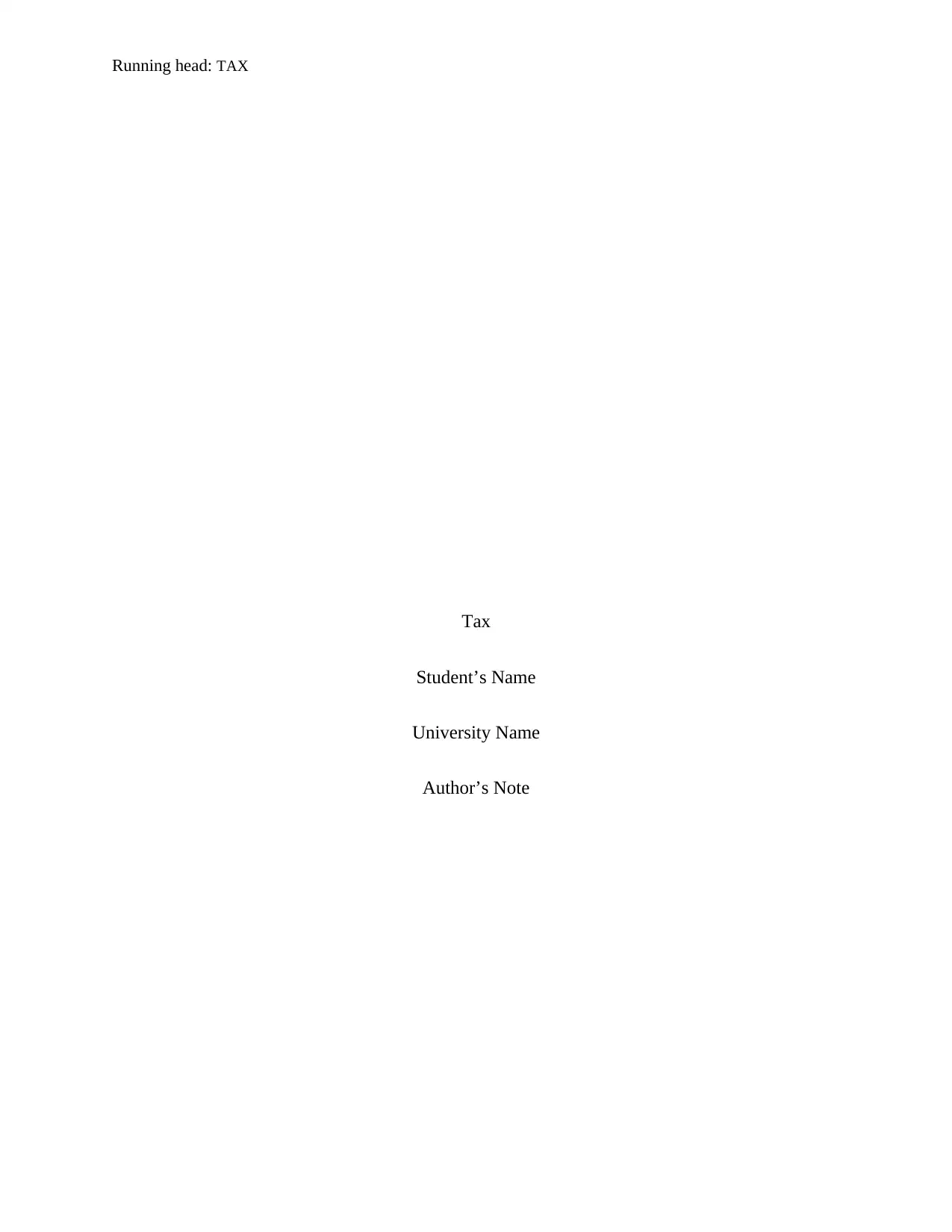
Running head: TAX
Tax
Student’s Name
University Name
Author’s Note
Tax
Student’s Name
University Name
Author’s Note
Paraphrase This Document
Need a fresh take? Get an instant paraphrase of this document with our AI Paraphraser
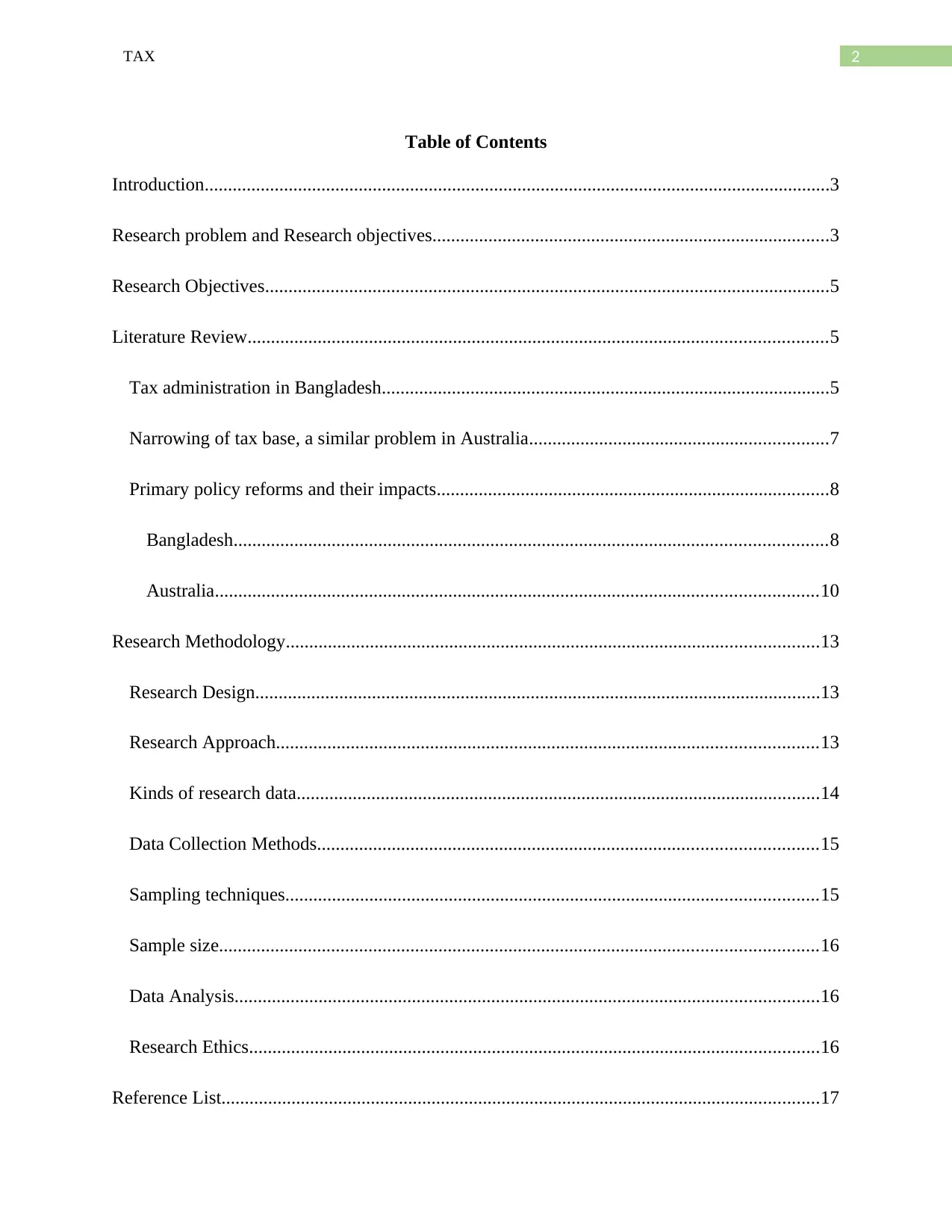
2TAX
Table of Contents
Introduction......................................................................................................................................3
Research problem and Research objectives.....................................................................................3
Research Objectives.........................................................................................................................5
Literature Review............................................................................................................................5
Tax administration in Bangladesh................................................................................................5
Narrowing of tax base, a similar problem in Australia................................................................7
Primary policy reforms and their impacts....................................................................................8
Bangladesh...............................................................................................................................8
Australia.................................................................................................................................10
Research Methodology..................................................................................................................13
Research Design.........................................................................................................................13
Research Approach....................................................................................................................13
Kinds of research data................................................................................................................14
Data Collection Methods...........................................................................................................15
Sampling techniques..................................................................................................................15
Sample size................................................................................................................................16
Data Analysis.............................................................................................................................16
Research Ethics..........................................................................................................................16
Reference List................................................................................................................................17
Table of Contents
Introduction......................................................................................................................................3
Research problem and Research objectives.....................................................................................3
Research Objectives.........................................................................................................................5
Literature Review............................................................................................................................5
Tax administration in Bangladesh................................................................................................5
Narrowing of tax base, a similar problem in Australia................................................................7
Primary policy reforms and their impacts....................................................................................8
Bangladesh...............................................................................................................................8
Australia.................................................................................................................................10
Research Methodology..................................................................................................................13
Research Design.........................................................................................................................13
Research Approach....................................................................................................................13
Kinds of research data................................................................................................................14
Data Collection Methods...........................................................................................................15
Sampling techniques..................................................................................................................15
Sample size................................................................................................................................16
Data Analysis.............................................................................................................................16
Research Ethics..........................................................................................................................16
Reference List................................................................................................................................17

3TAX
⊘ This is a preview!⊘
Do you want full access?
Subscribe today to unlock all pages.

Trusted by 1+ million students worldwide
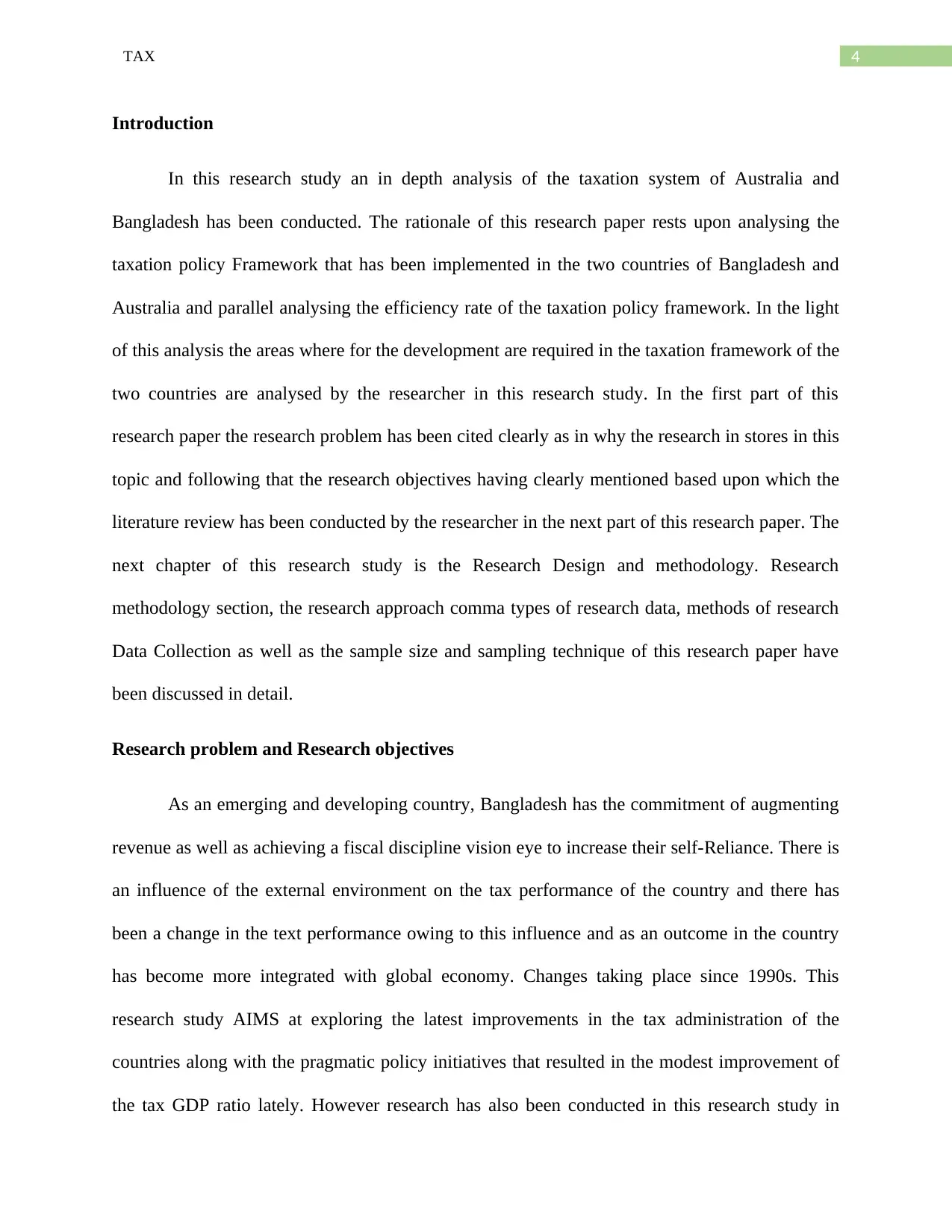
4TAX
Introduction
In this research study an in depth analysis of the taxation system of Australia and
Bangladesh has been conducted. The rationale of this research paper rests upon analysing the
taxation policy Framework that has been implemented in the two countries of Bangladesh and
Australia and parallel analysing the efficiency rate of the taxation policy framework. In the light
of this analysis the areas where for the development are required in the taxation framework of the
two countries are analysed by the researcher in this research study. In the first part of this
research paper the research problem has been cited clearly as in why the research in stores in this
topic and following that the research objectives having clearly mentioned based upon which the
literature review has been conducted by the researcher in the next part of this research paper. The
next chapter of this research study is the Research Design and methodology. Research
methodology section, the research approach comma types of research data, methods of research
Data Collection as well as the sample size and sampling technique of this research paper have
been discussed in detail.
Research problem and Research objectives
As an emerging and developing country, Bangladesh has the commitment of augmenting
revenue as well as achieving a fiscal discipline vision eye to increase their self-Reliance. There is
an influence of the external environment on the tax performance of the country and there has
been a change in the text performance owing to this influence and as an outcome in the country
has become more integrated with global economy. Changes taking place since 1990s. This
research study AIMS at exploring the latest improvements in the tax administration of the
countries along with the pragmatic policy initiatives that resulted in the modest improvement of
the tax GDP ratio lately. However research has also been conducted in this research study in
Introduction
In this research study an in depth analysis of the taxation system of Australia and
Bangladesh has been conducted. The rationale of this research paper rests upon analysing the
taxation policy Framework that has been implemented in the two countries of Bangladesh and
Australia and parallel analysing the efficiency rate of the taxation policy framework. In the light
of this analysis the areas where for the development are required in the taxation framework of the
two countries are analysed by the researcher in this research study. In the first part of this
research paper the research problem has been cited clearly as in why the research in stores in this
topic and following that the research objectives having clearly mentioned based upon which the
literature review has been conducted by the researcher in the next part of this research paper. The
next chapter of this research study is the Research Design and methodology. Research
methodology section, the research approach comma types of research data, methods of research
Data Collection as well as the sample size and sampling technique of this research paper have
been discussed in detail.
Research problem and Research objectives
As an emerging and developing country, Bangladesh has the commitment of augmenting
revenue as well as achieving a fiscal discipline vision eye to increase their self-Reliance. There is
an influence of the external environment on the tax performance of the country and there has
been a change in the text performance owing to this influence and as an outcome in the country
has become more integrated with global economy. Changes taking place since 1990s. This
research study AIMS at exploring the latest improvements in the tax administration of the
countries along with the pragmatic policy initiatives that resulted in the modest improvement of
the tax GDP ratio lately. However research has also been conducted in this research study in
Paraphrase This Document
Need a fresh take? Get an instant paraphrase of this document with our AI Paraphraser
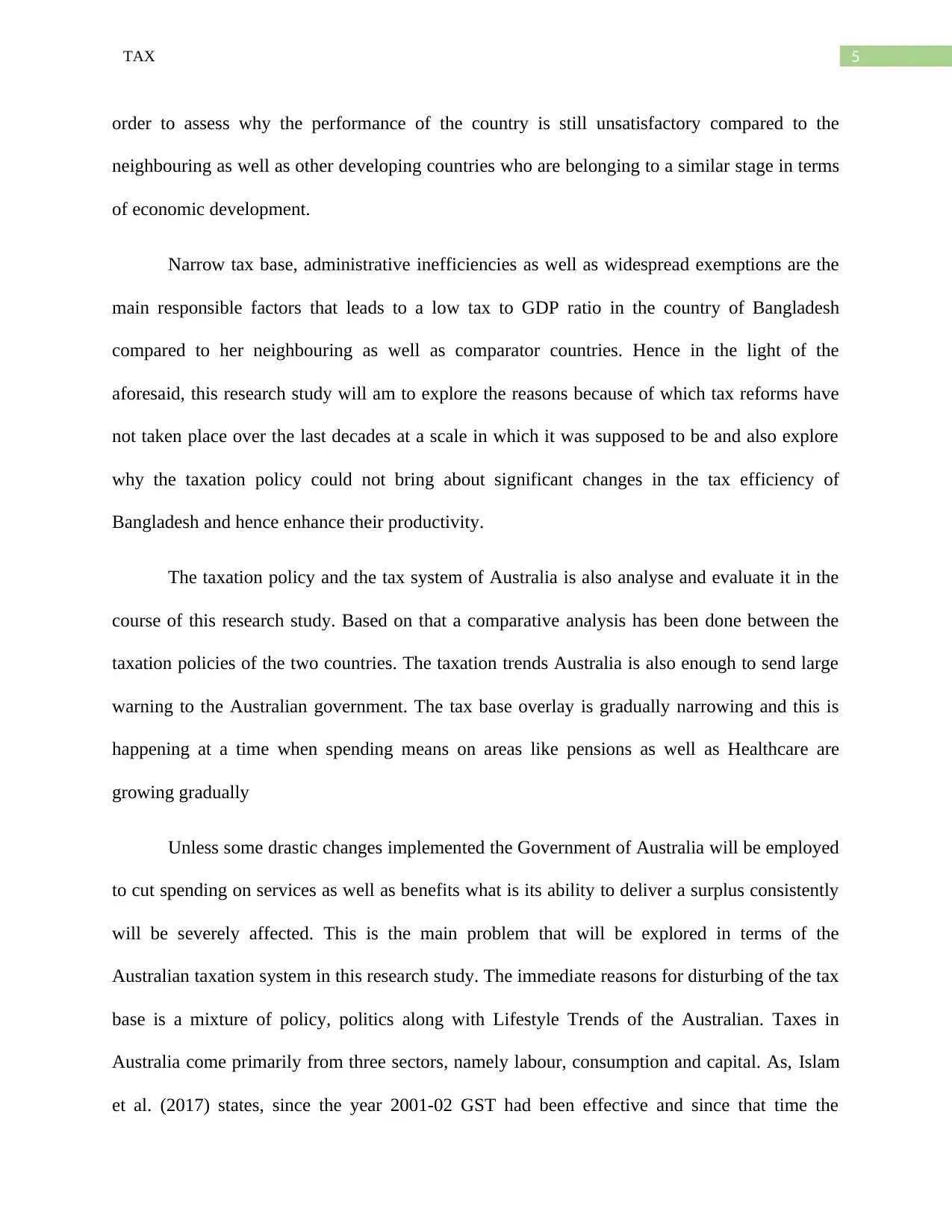
5TAX
order to assess why the performance of the country is still unsatisfactory compared to the
neighbouring as well as other developing countries who are belonging to a similar stage in terms
of economic development.
Narrow tax base, administrative inefficiencies as well as widespread exemptions are the
main responsible factors that leads to a low tax to GDP ratio in the country of Bangladesh
compared to her neighbouring as well as comparator countries. Hence in the light of the
aforesaid, this research study will am to explore the reasons because of which tax reforms have
not taken place over the last decades at a scale in which it was supposed to be and also explore
why the taxation policy could not bring about significant changes in the tax efficiency of
Bangladesh and hence enhance their productivity.
The taxation policy and the tax system of Australia is also analyse and evaluate it in the
course of this research study. Based on that a comparative analysis has been done between the
taxation policies of the two countries. The taxation trends Australia is also enough to send large
warning to the Australian government. The tax base overlay is gradually narrowing and this is
happening at a time when spending means on areas like pensions as well as Healthcare are
growing gradually
Unless some drastic changes implemented the Government of Australia will be employed
to cut spending on services as well as benefits what is its ability to deliver a surplus consistently
will be severely affected. This is the main problem that will be explored in terms of the
Australian taxation system in this research study. The immediate reasons for disturbing of the tax
base is a mixture of policy, politics along with Lifestyle Trends of the Australian. Taxes in
Australia come primarily from three sectors, namely labour, consumption and capital. As, Islam
et al. (2017) states, since the year 2001-02 GST had been effective and since that time the
order to assess why the performance of the country is still unsatisfactory compared to the
neighbouring as well as other developing countries who are belonging to a similar stage in terms
of economic development.
Narrow tax base, administrative inefficiencies as well as widespread exemptions are the
main responsible factors that leads to a low tax to GDP ratio in the country of Bangladesh
compared to her neighbouring as well as comparator countries. Hence in the light of the
aforesaid, this research study will am to explore the reasons because of which tax reforms have
not taken place over the last decades at a scale in which it was supposed to be and also explore
why the taxation policy could not bring about significant changes in the tax efficiency of
Bangladesh and hence enhance their productivity.
The taxation policy and the tax system of Australia is also analyse and evaluate it in the
course of this research study. Based on that a comparative analysis has been done between the
taxation policies of the two countries. The taxation trends Australia is also enough to send large
warning to the Australian government. The tax base overlay is gradually narrowing and this is
happening at a time when spending means on areas like pensions as well as Healthcare are
growing gradually
Unless some drastic changes implemented the Government of Australia will be employed
to cut spending on services as well as benefits what is its ability to deliver a surplus consistently
will be severely affected. This is the main problem that will be explored in terms of the
Australian taxation system in this research study. The immediate reasons for disturbing of the tax
base is a mixture of policy, politics along with Lifestyle Trends of the Australian. Taxes in
Australia come primarily from three sectors, namely labour, consumption and capital. As, Islam
et al. (2017) states, since the year 2001-02 GST had been effective and since that time the
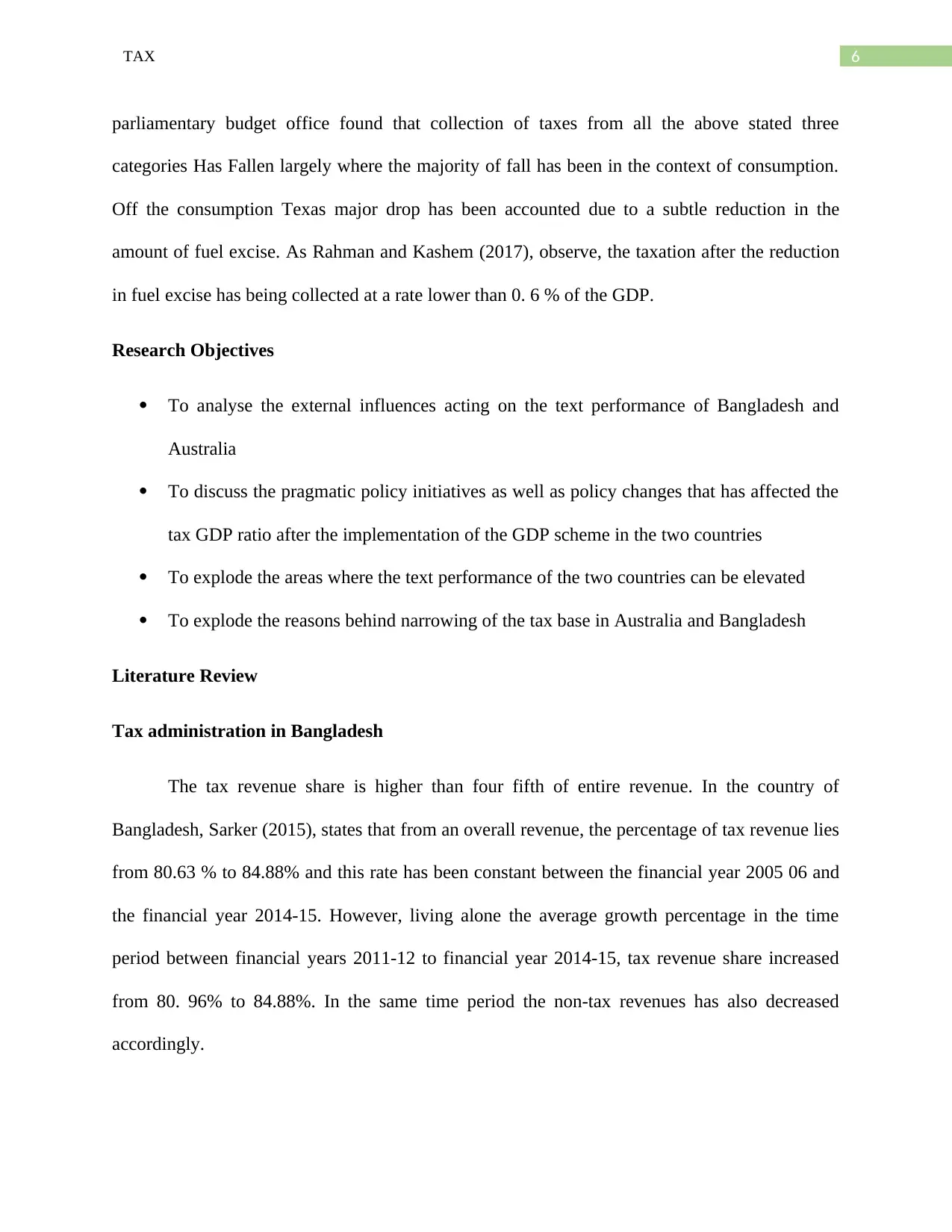
6TAX
parliamentary budget office found that collection of taxes from all the above stated three
categories Has Fallen largely where the majority of fall has been in the context of consumption.
Off the consumption Texas major drop has been accounted due to a subtle reduction in the
amount of fuel excise. As Rahman and Kashem (2017), observe, the taxation after the reduction
in fuel excise has being collected at a rate lower than 0. 6 % of the GDP.
Research Objectives
To analyse the external influences acting on the text performance of Bangladesh and
Australia
To discuss the pragmatic policy initiatives as well as policy changes that has affected the
tax GDP ratio after the implementation of the GDP scheme in the two countries
To explode the areas where the text performance of the two countries can be elevated
To explode the reasons behind narrowing of the tax base in Australia and Bangladesh
Literature Review
Tax administration in Bangladesh
The tax revenue share is higher than four fifth of entire revenue. In the country of
Bangladesh, Sarker (2015), states that from an overall revenue, the percentage of tax revenue lies
from 80.63 % to 84.88% and this rate has been constant between the financial year 2005 06 and
the financial year 2014-15. However, living alone the average growth percentage in the time
period between financial years 2011-12 to financial year 2014-15, tax revenue share increased
from 80. 96% to 84.88%. In the same time period the non-tax revenues has also decreased
accordingly.
parliamentary budget office found that collection of taxes from all the above stated three
categories Has Fallen largely where the majority of fall has been in the context of consumption.
Off the consumption Texas major drop has been accounted due to a subtle reduction in the
amount of fuel excise. As Rahman and Kashem (2017), observe, the taxation after the reduction
in fuel excise has being collected at a rate lower than 0. 6 % of the GDP.
Research Objectives
To analyse the external influences acting on the text performance of Bangladesh and
Australia
To discuss the pragmatic policy initiatives as well as policy changes that has affected the
tax GDP ratio after the implementation of the GDP scheme in the two countries
To explode the areas where the text performance of the two countries can be elevated
To explode the reasons behind narrowing of the tax base in Australia and Bangladesh
Literature Review
Tax administration in Bangladesh
The tax revenue share is higher than four fifth of entire revenue. In the country of
Bangladesh, Sarker (2015), states that from an overall revenue, the percentage of tax revenue lies
from 80.63 % to 84.88% and this rate has been constant between the financial year 2005 06 and
the financial year 2014-15. However, living alone the average growth percentage in the time
period between financial years 2011-12 to financial year 2014-15, tax revenue share increased
from 80. 96% to 84.88%. In the same time period the non-tax revenues has also decreased
accordingly.
⊘ This is a preview!⊘
Do you want full access?
Subscribe today to unlock all pages.

Trusted by 1+ million students worldwide
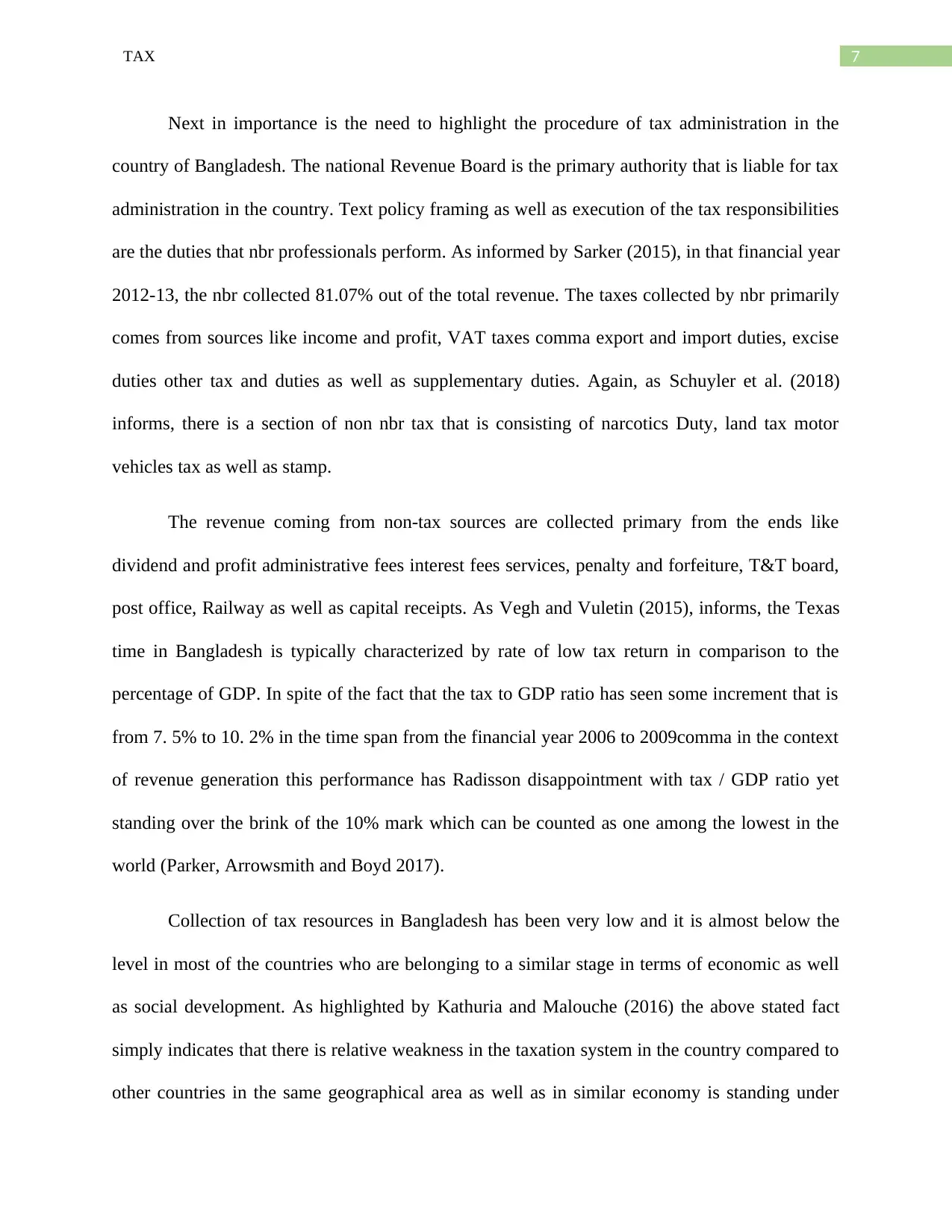
7TAX
Next in importance is the need to highlight the procedure of tax administration in the
country of Bangladesh. The national Revenue Board is the primary authority that is liable for tax
administration in the country. Text policy framing as well as execution of the tax responsibilities
are the duties that nbr professionals perform. As informed by Sarker (2015), in that financial year
2012-13, the nbr collected 81.07% out of the total revenue. The taxes collected by nbr primarily
comes from sources like income and profit, VAT taxes comma export and import duties, excise
duties other tax and duties as well as supplementary duties. Again, as Schuyler et al. (2018)
informs, there is a section of non nbr tax that is consisting of narcotics Duty, land tax motor
vehicles tax as well as stamp.
The revenue coming from non-tax sources are collected primary from the ends like
dividend and profit administrative fees interest fees services, penalty and forfeiture, T&T board,
post office, Railway as well as capital receipts. As Vegh and Vuletin (2015), informs, the Texas
time in Bangladesh is typically characterized by rate of low tax return in comparison to the
percentage of GDP. In spite of the fact that the tax to GDP ratio has seen some increment that is
from 7. 5% to 10. 2% in the time span from the financial year 2006 to 2009comma in the context
of revenue generation this performance has Radisson disappointment with tax / GDP ratio yet
standing over the brink of the 10% mark which can be counted as one among the lowest in the
world (Parker, Arrowsmith and Boyd 2017).
Collection of tax resources in Bangladesh has been very low and it is almost below the
level in most of the countries who are belonging to a similar stage in terms of economic as well
as social development. As highlighted by Kathuria and Malouche (2016) the above stated fact
simply indicates that there is relative weakness in the taxation system in the country compared to
other countries in the same geographical area as well as in similar economy is standing under
Next in importance is the need to highlight the procedure of tax administration in the
country of Bangladesh. The national Revenue Board is the primary authority that is liable for tax
administration in the country. Text policy framing as well as execution of the tax responsibilities
are the duties that nbr professionals perform. As informed by Sarker (2015), in that financial year
2012-13, the nbr collected 81.07% out of the total revenue. The taxes collected by nbr primarily
comes from sources like income and profit, VAT taxes comma export and import duties, excise
duties other tax and duties as well as supplementary duties. Again, as Schuyler et al. (2018)
informs, there is a section of non nbr tax that is consisting of narcotics Duty, land tax motor
vehicles tax as well as stamp.
The revenue coming from non-tax sources are collected primary from the ends like
dividend and profit administrative fees interest fees services, penalty and forfeiture, T&T board,
post office, Railway as well as capital receipts. As Vegh and Vuletin (2015), informs, the Texas
time in Bangladesh is typically characterized by rate of low tax return in comparison to the
percentage of GDP. In spite of the fact that the tax to GDP ratio has seen some increment that is
from 7. 5% to 10. 2% in the time span from the financial year 2006 to 2009comma in the context
of revenue generation this performance has Radisson disappointment with tax / GDP ratio yet
standing over the brink of the 10% mark which can be counted as one among the lowest in the
world (Parker, Arrowsmith and Boyd 2017).
Collection of tax resources in Bangladesh has been very low and it is almost below the
level in most of the countries who are belonging to a similar stage in terms of economic as well
as social development. As highlighted by Kathuria and Malouche (2016) the above stated fact
simply indicates that there is relative weakness in the taxation system in the country compared to
other countries in the same geographical area as well as in similar economy is standing under
Paraphrase This Document
Need a fresh take? Get an instant paraphrase of this document with our AI Paraphraser
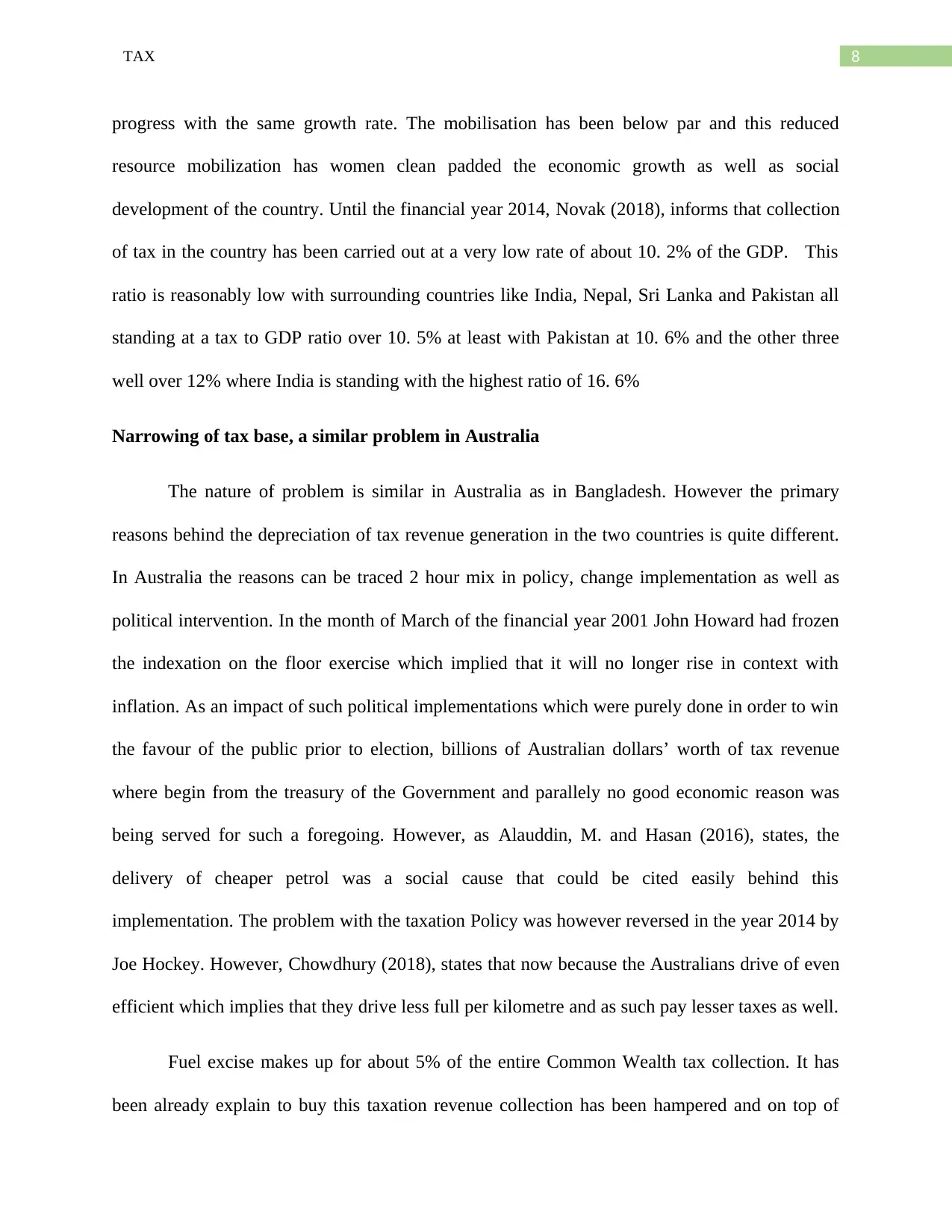
8TAX
progress with the same growth rate. The mobilisation has been below par and this reduced
resource mobilization has women clean padded the economic growth as well as social
development of the country. Until the financial year 2014, Novak (2018), informs that collection
of tax in the country has been carried out at a very low rate of about 10. 2% of the GDP. This
ratio is reasonably low with surrounding countries like India, Nepal, Sri Lanka and Pakistan all
standing at a tax to GDP ratio over 10. 5% at least with Pakistan at 10. 6% and the other three
well over 12% where India is standing with the highest ratio of 16. 6%
Narrowing of tax base, a similar problem in Australia
The nature of problem is similar in Australia as in Bangladesh. However the primary
reasons behind the depreciation of tax revenue generation in the two countries is quite different.
In Australia the reasons can be traced 2 hour mix in policy, change implementation as well as
political intervention. In the month of March of the financial year 2001 John Howard had frozen
the indexation on the floor exercise which implied that it will no longer rise in context with
inflation. As an impact of such political implementations which were purely done in order to win
the favour of the public prior to election, billions of Australian dollars’ worth of tax revenue
where begin from the treasury of the Government and parallely no good economic reason was
being served for such a foregoing. However, as Alauddin, M. and Hasan (2016), states, the
delivery of cheaper petrol was a social cause that could be cited easily behind this
implementation. The problem with the taxation Policy was however reversed in the year 2014 by
Joe Hockey. However, Chowdhury (2018), states that now because the Australians drive of even
efficient which implies that they drive less full per kilometre and as such pay lesser taxes as well.
Fuel excise makes up for about 5% of the entire Common Wealth tax collection. It has
been already explain to buy this taxation revenue collection has been hampered and on top of
progress with the same growth rate. The mobilisation has been below par and this reduced
resource mobilization has women clean padded the economic growth as well as social
development of the country. Until the financial year 2014, Novak (2018), informs that collection
of tax in the country has been carried out at a very low rate of about 10. 2% of the GDP. This
ratio is reasonably low with surrounding countries like India, Nepal, Sri Lanka and Pakistan all
standing at a tax to GDP ratio over 10. 5% at least with Pakistan at 10. 6% and the other three
well over 12% where India is standing with the highest ratio of 16. 6%
Narrowing of tax base, a similar problem in Australia
The nature of problem is similar in Australia as in Bangladesh. However the primary
reasons behind the depreciation of tax revenue generation in the two countries is quite different.
In Australia the reasons can be traced 2 hour mix in policy, change implementation as well as
political intervention. In the month of March of the financial year 2001 John Howard had frozen
the indexation on the floor exercise which implied that it will no longer rise in context with
inflation. As an impact of such political implementations which were purely done in order to win
the favour of the public prior to election, billions of Australian dollars’ worth of tax revenue
where begin from the treasury of the Government and parallely no good economic reason was
being served for such a foregoing. However, as Alauddin, M. and Hasan (2016), states, the
delivery of cheaper petrol was a social cause that could be cited easily behind this
implementation. The problem with the taxation Policy was however reversed in the year 2014 by
Joe Hockey. However, Chowdhury (2018), states that now because the Australians drive of even
efficient which implies that they drive less full per kilometre and as such pay lesser taxes as well.
Fuel excise makes up for about 5% of the entire Common Wealth tax collection. It has
been already explain to buy this taxation revenue collection has been hampered and on top of
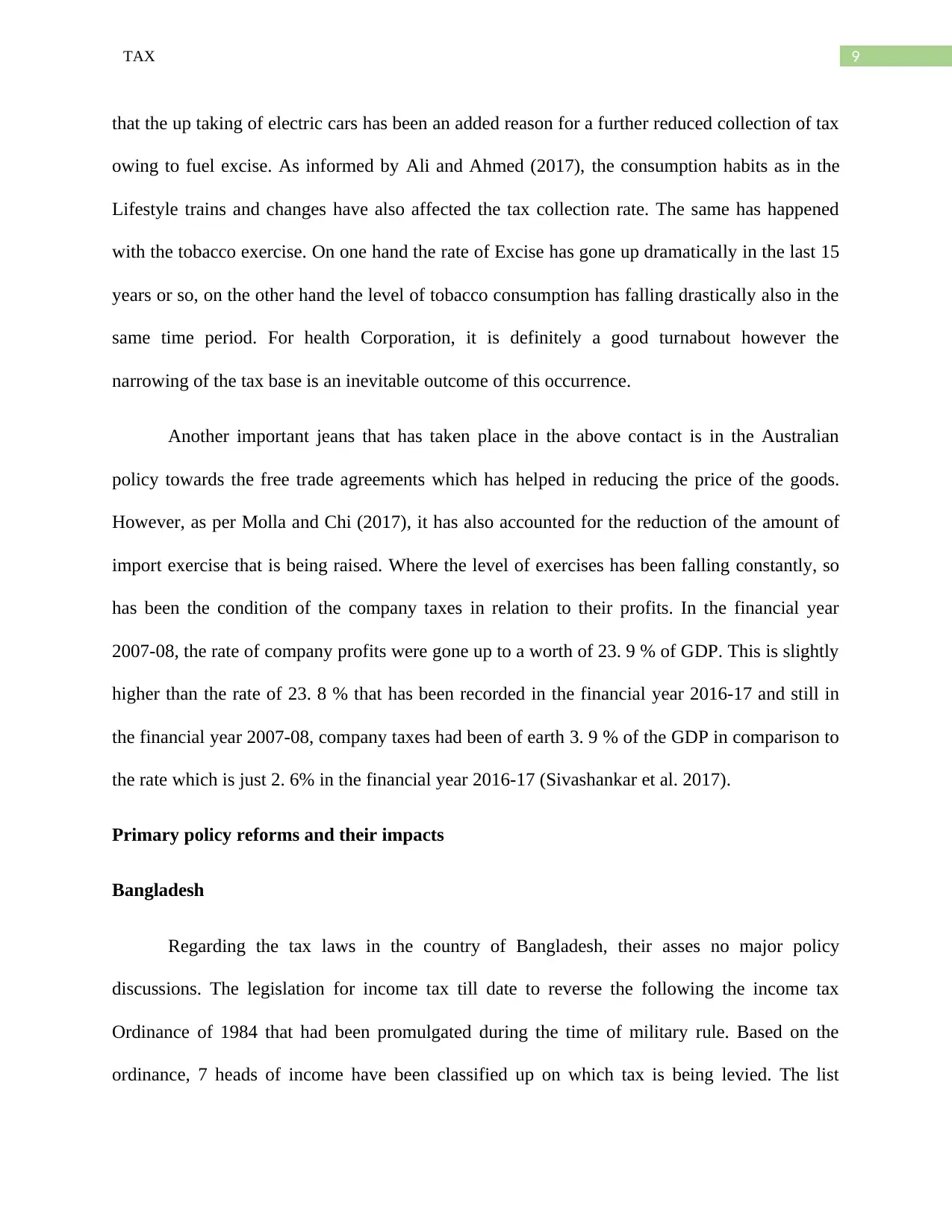
9TAX
that the up taking of electric cars has been an added reason for a further reduced collection of tax
owing to fuel excise. As informed by Ali and Ahmed (2017), the consumption habits as in the
Lifestyle trains and changes have also affected the tax collection rate. The same has happened
with the tobacco exercise. On one hand the rate of Excise has gone up dramatically in the last 15
years or so, on the other hand the level of tobacco consumption has falling drastically also in the
same time period. For health Corporation, it is definitely a good turnabout however the
narrowing of the tax base is an inevitable outcome of this occurrence.
Another important jeans that has taken place in the above contact is in the Australian
policy towards the free trade agreements which has helped in reducing the price of the goods.
However, as per Molla and Chi (2017), it has also accounted for the reduction of the amount of
import exercise that is being raised. Where the level of exercises has been falling constantly, so
has been the condition of the company taxes in relation to their profits. In the financial year
2007-08, the rate of company profits were gone up to a worth of 23. 9 % of GDP. This is slightly
higher than the rate of 23. 8 % that has been recorded in the financial year 2016-17 and still in
the financial year 2007-08, company taxes had been of earth 3. 9 % of the GDP in comparison to
the rate which is just 2. 6% in the financial year 2016-17 (Sivashankar et al. 2017).
Primary policy reforms and their impacts
Bangladesh
Regarding the tax laws in the country of Bangladesh, their asses no major policy
discussions. The legislation for income tax till date to reverse the following the income tax
Ordinance of 1984 that had been promulgated during the time of military rule. Based on the
ordinance, 7 heads of income have been classified up on which tax is being levied. The list
that the up taking of electric cars has been an added reason for a further reduced collection of tax
owing to fuel excise. As informed by Ali and Ahmed (2017), the consumption habits as in the
Lifestyle trains and changes have also affected the tax collection rate. The same has happened
with the tobacco exercise. On one hand the rate of Excise has gone up dramatically in the last 15
years or so, on the other hand the level of tobacco consumption has falling drastically also in the
same time period. For health Corporation, it is definitely a good turnabout however the
narrowing of the tax base is an inevitable outcome of this occurrence.
Another important jeans that has taken place in the above contact is in the Australian
policy towards the free trade agreements which has helped in reducing the price of the goods.
However, as per Molla and Chi (2017), it has also accounted for the reduction of the amount of
import exercise that is being raised. Where the level of exercises has been falling constantly, so
has been the condition of the company taxes in relation to their profits. In the financial year
2007-08, the rate of company profits were gone up to a worth of 23. 9 % of GDP. This is slightly
higher than the rate of 23. 8 % that has been recorded in the financial year 2016-17 and still in
the financial year 2007-08, company taxes had been of earth 3. 9 % of the GDP in comparison to
the rate which is just 2. 6% in the financial year 2016-17 (Sivashankar et al. 2017).
Primary policy reforms and their impacts
Bangladesh
Regarding the tax laws in the country of Bangladesh, their asses no major policy
discussions. The legislation for income tax till date to reverse the following the income tax
Ordinance of 1984 that had been promulgated during the time of military rule. Based on the
ordinance, 7 heads of income have been classified up on which tax is being levied. The list
⊘ This is a preview!⊘
Do you want full access?
Subscribe today to unlock all pages.

Trusted by 1+ million students worldwide
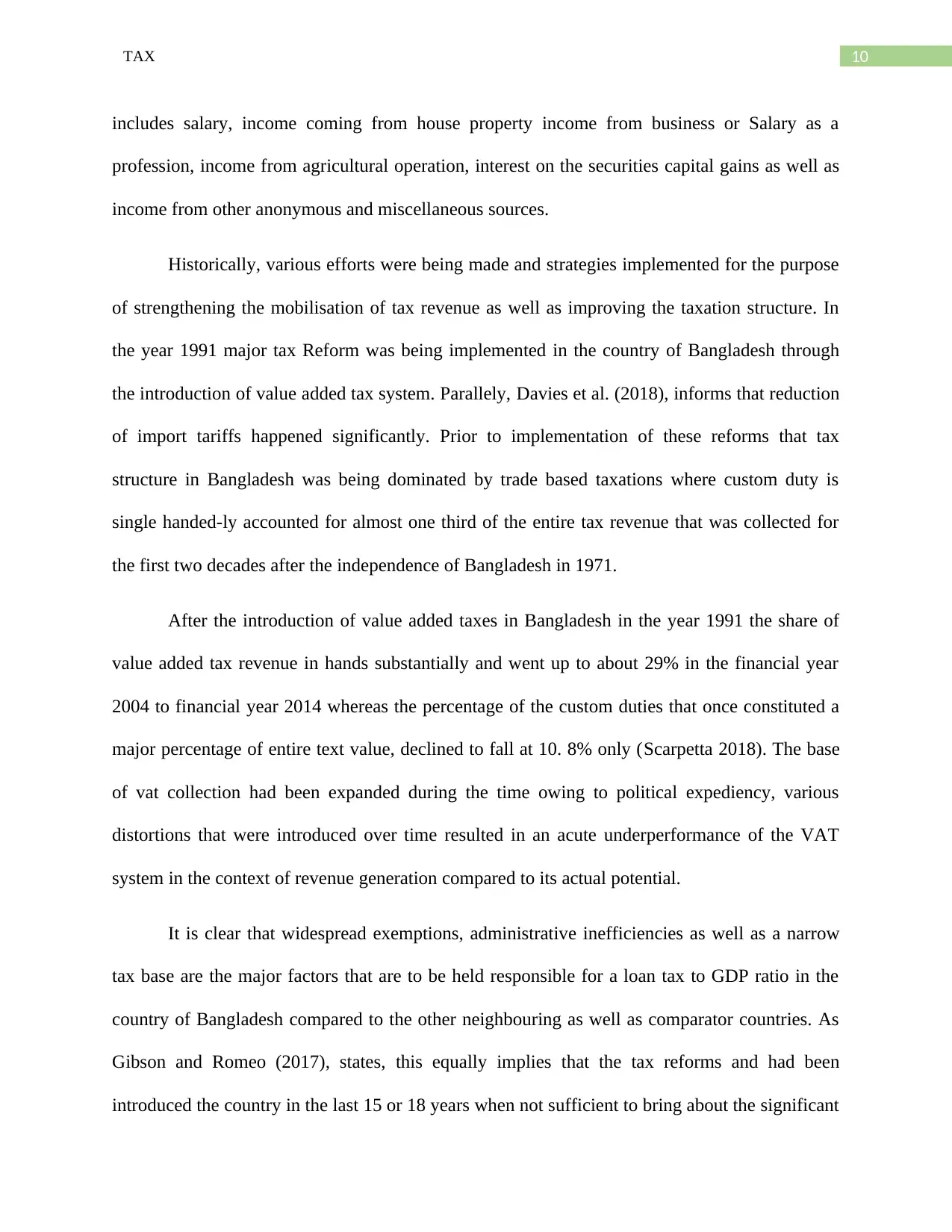
10TAX
includes salary, income coming from house property income from business or Salary as a
profession, income from agricultural operation, interest on the securities capital gains as well as
income from other anonymous and miscellaneous sources.
Historically, various efforts were being made and strategies implemented for the purpose
of strengthening the mobilisation of tax revenue as well as improving the taxation structure. In
the year 1991 major tax Reform was being implemented in the country of Bangladesh through
the introduction of value added tax system. Parallely, Davies et al. (2018), informs that reduction
of import tariffs happened significantly. Prior to implementation of these reforms that tax
structure in Bangladesh was being dominated by trade based taxations where custom duty is
single handed-ly accounted for almost one third of the entire tax revenue that was collected for
the first two decades after the independence of Bangladesh in 1971.
After the introduction of value added taxes in Bangladesh in the year 1991 the share of
value added tax revenue in hands substantially and went up to about 29% in the financial year
2004 to financial year 2014 whereas the percentage of the custom duties that once constituted a
major percentage of entire text value, declined to fall at 10. 8% only (Scarpetta 2018). The base
of vat collection had been expanded during the time owing to political expediency, various
distortions that were introduced over time resulted in an acute underperformance of the VAT
system in the context of revenue generation compared to its actual potential.
It is clear that widespread exemptions, administrative inefficiencies as well as a narrow
tax base are the major factors that are to be held responsible for a loan tax to GDP ratio in the
country of Bangladesh compared to the other neighbouring as well as comparator countries. As
Gibson and Romeo (2017), states, this equally implies that the tax reforms and had been
introduced the country in the last 15 or 18 years when not sufficient to bring about the significant
includes salary, income coming from house property income from business or Salary as a
profession, income from agricultural operation, interest on the securities capital gains as well as
income from other anonymous and miscellaneous sources.
Historically, various efforts were being made and strategies implemented for the purpose
of strengthening the mobilisation of tax revenue as well as improving the taxation structure. In
the year 1991 major tax Reform was being implemented in the country of Bangladesh through
the introduction of value added tax system. Parallely, Davies et al. (2018), informs that reduction
of import tariffs happened significantly. Prior to implementation of these reforms that tax
structure in Bangladesh was being dominated by trade based taxations where custom duty is
single handed-ly accounted for almost one third of the entire tax revenue that was collected for
the first two decades after the independence of Bangladesh in 1971.
After the introduction of value added taxes in Bangladesh in the year 1991 the share of
value added tax revenue in hands substantially and went up to about 29% in the financial year
2004 to financial year 2014 whereas the percentage of the custom duties that once constituted a
major percentage of entire text value, declined to fall at 10. 8% only (Scarpetta 2018). The base
of vat collection had been expanded during the time owing to political expediency, various
distortions that were introduced over time resulted in an acute underperformance of the VAT
system in the context of revenue generation compared to its actual potential.
It is clear that widespread exemptions, administrative inefficiencies as well as a narrow
tax base are the major factors that are to be held responsible for a loan tax to GDP ratio in the
country of Bangladesh compared to the other neighbouring as well as comparator countries. As
Gibson and Romeo (2017), states, this equally implies that the tax reforms and had been
introduced the country in the last 15 or 18 years when not sufficient to bring about the significant
Paraphrase This Document
Need a fresh take? Get an instant paraphrase of this document with our AI Paraphraser
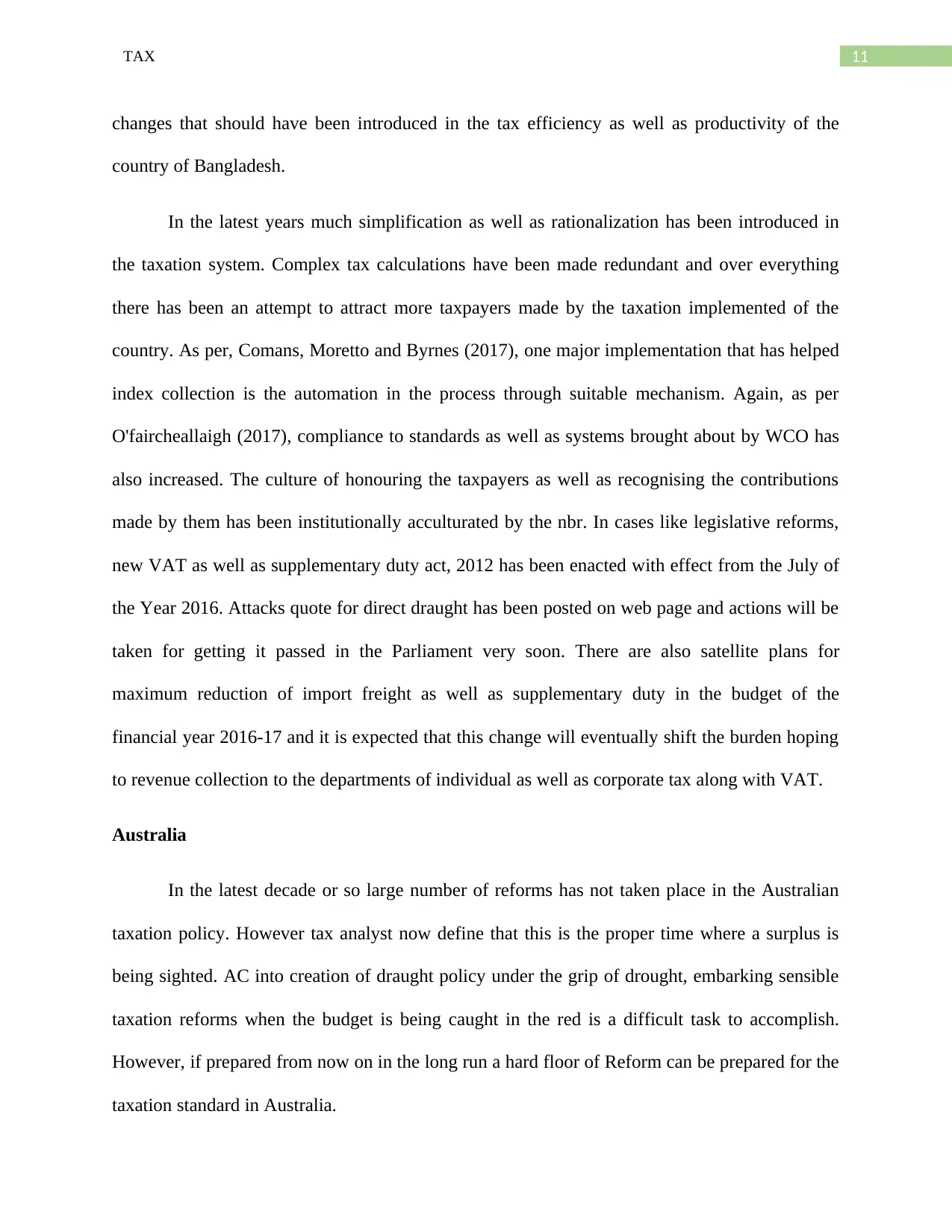
11TAX
changes that should have been introduced in the tax efficiency as well as productivity of the
country of Bangladesh.
In the latest years much simplification as well as rationalization has been introduced in
the taxation system. Complex tax calculations have been made redundant and over everything
there has been an attempt to attract more taxpayers made by the taxation implemented of the
country. As per, Comans, Moretto and Byrnes (2017), one major implementation that has helped
index collection is the automation in the process through suitable mechanism. Again, as per
O'faircheallaigh (2017), compliance to standards as well as systems brought about by WCO has
also increased. The culture of honouring the taxpayers as well as recognising the contributions
made by them has been institutionally acculturated by the nbr. In cases like legislative reforms,
new VAT as well as supplementary duty act, 2012 has been enacted with effect from the July of
the Year 2016. Attacks quote for direct draught has been posted on web page and actions will be
taken for getting it passed in the Parliament very soon. There are also satellite plans for
maximum reduction of import freight as well as supplementary duty in the budget of the
financial year 2016-17 and it is expected that this change will eventually shift the burden hoping
to revenue collection to the departments of individual as well as corporate tax along with VAT.
Australia
In the latest decade or so large number of reforms has not taken place in the Australian
taxation policy. However tax analyst now define that this is the proper time where a surplus is
being sighted. AC into creation of draught policy under the grip of drought, embarking sensible
taxation reforms when the budget is being caught in the red is a difficult task to accomplish.
However, if prepared from now on in the long run a hard floor of Reform can be prepared for the
taxation standard in Australia.
changes that should have been introduced in the tax efficiency as well as productivity of the
country of Bangladesh.
In the latest years much simplification as well as rationalization has been introduced in
the taxation system. Complex tax calculations have been made redundant and over everything
there has been an attempt to attract more taxpayers made by the taxation implemented of the
country. As per, Comans, Moretto and Byrnes (2017), one major implementation that has helped
index collection is the automation in the process through suitable mechanism. Again, as per
O'faircheallaigh (2017), compliance to standards as well as systems brought about by WCO has
also increased. The culture of honouring the taxpayers as well as recognising the contributions
made by them has been institutionally acculturated by the nbr. In cases like legislative reforms,
new VAT as well as supplementary duty act, 2012 has been enacted with effect from the July of
the Year 2016. Attacks quote for direct draught has been posted on web page and actions will be
taken for getting it passed in the Parliament very soon. There are also satellite plans for
maximum reduction of import freight as well as supplementary duty in the budget of the
financial year 2016-17 and it is expected that this change will eventually shift the burden hoping
to revenue collection to the departments of individual as well as corporate tax along with VAT.
Australia
In the latest decade or so large number of reforms has not taken place in the Australian
taxation policy. However tax analyst now define that this is the proper time where a surplus is
being sighted. AC into creation of draught policy under the grip of drought, embarking sensible
taxation reforms when the budget is being caught in the red is a difficult task to accomplish.
However, if prepared from now on in the long run a hard floor of Reform can be prepared for the
taxation standard in Australia.
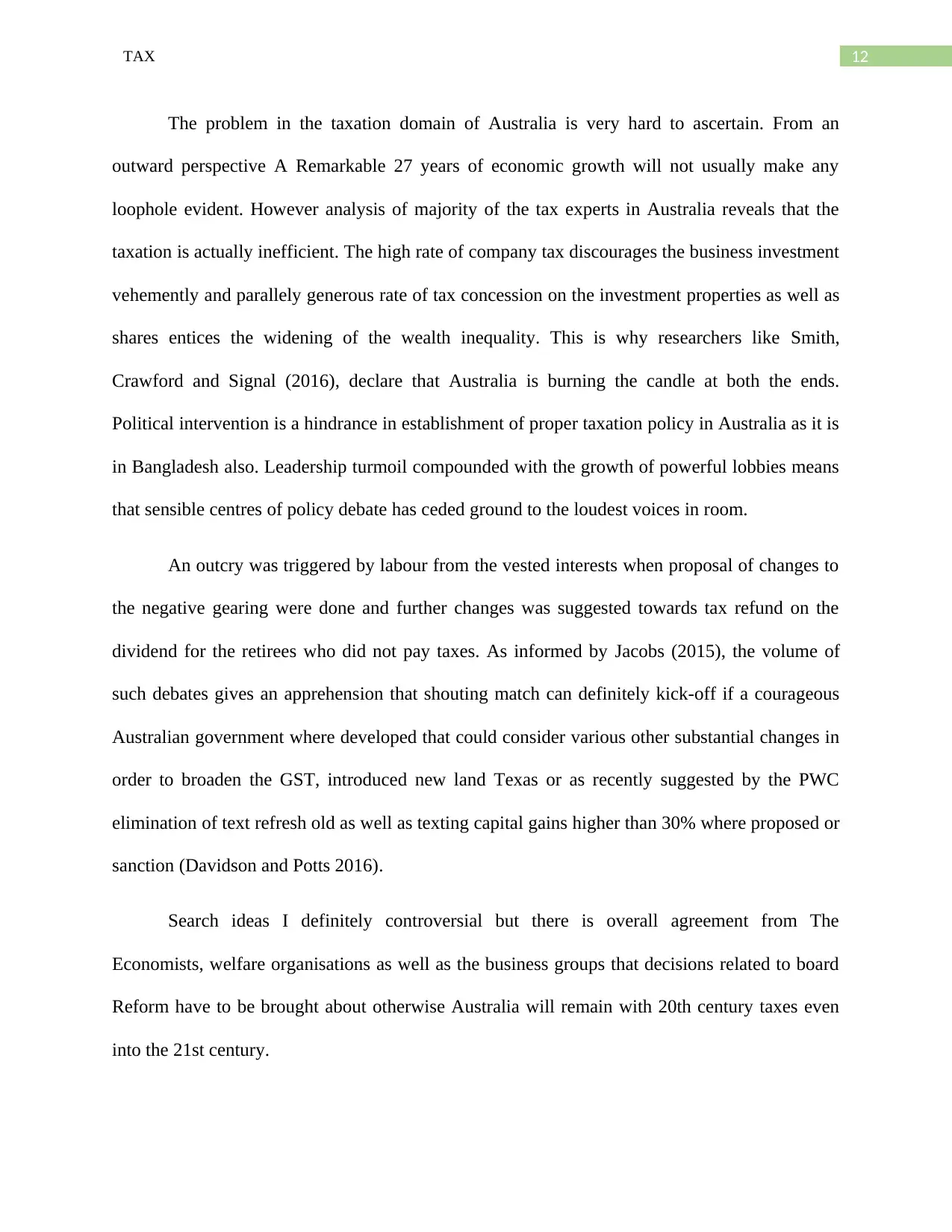
12TAX
The problem in the taxation domain of Australia is very hard to ascertain. From an
outward perspective A Remarkable 27 years of economic growth will not usually make any
loophole evident. However analysis of majority of the tax experts in Australia reveals that the
taxation is actually inefficient. The high rate of company tax discourages the business investment
vehemently and parallely generous rate of tax concession on the investment properties as well as
shares entices the widening of the wealth inequality. This is why researchers like Smith,
Crawford and Signal (2016), declare that Australia is burning the candle at both the ends.
Political intervention is a hindrance in establishment of proper taxation policy in Australia as it is
in Bangladesh also. Leadership turmoil compounded with the growth of powerful lobbies means
that sensible centres of policy debate has ceded ground to the loudest voices in room.
An outcry was triggered by labour from the vested interests when proposal of changes to
the negative gearing were done and further changes was suggested towards tax refund on the
dividend for the retirees who did not pay taxes. As informed by Jacobs (2015), the volume of
such debates gives an apprehension that shouting match can definitely kick-off if a courageous
Australian government where developed that could consider various other substantial changes in
order to broaden the GST, introduced new land Texas or as recently suggested by the PWC
elimination of text refresh old as well as texting capital gains higher than 30% where proposed or
sanction (Davidson and Potts 2016).
Search ideas I definitely controversial but there is overall agreement from The
Economists, welfare organisations as well as the business groups that decisions related to board
Reform have to be brought about otherwise Australia will remain with 20th century taxes even
into the 21st century.
The problem in the taxation domain of Australia is very hard to ascertain. From an
outward perspective A Remarkable 27 years of economic growth will not usually make any
loophole evident. However analysis of majority of the tax experts in Australia reveals that the
taxation is actually inefficient. The high rate of company tax discourages the business investment
vehemently and parallely generous rate of tax concession on the investment properties as well as
shares entices the widening of the wealth inequality. This is why researchers like Smith,
Crawford and Signal (2016), declare that Australia is burning the candle at both the ends.
Political intervention is a hindrance in establishment of proper taxation policy in Australia as it is
in Bangladesh also. Leadership turmoil compounded with the growth of powerful lobbies means
that sensible centres of policy debate has ceded ground to the loudest voices in room.
An outcry was triggered by labour from the vested interests when proposal of changes to
the negative gearing were done and further changes was suggested towards tax refund on the
dividend for the retirees who did not pay taxes. As informed by Jacobs (2015), the volume of
such debates gives an apprehension that shouting match can definitely kick-off if a courageous
Australian government where developed that could consider various other substantial changes in
order to broaden the GST, introduced new land Texas or as recently suggested by the PWC
elimination of text refresh old as well as texting capital gains higher than 30% where proposed or
sanction (Davidson and Potts 2016).
Search ideas I definitely controversial but there is overall agreement from The
Economists, welfare organisations as well as the business groups that decisions related to board
Reform have to be brought about otherwise Australia will remain with 20th century taxes even
into the 21st century.
⊘ This is a preview!⊘
Do you want full access?
Subscribe today to unlock all pages.

Trusted by 1+ million students worldwide
1 out of 23
Related Documents
Your All-in-One AI-Powered Toolkit for Academic Success.
+13062052269
info@desklib.com
Available 24*7 on WhatsApp / Email
![[object Object]](/_next/static/media/star-bottom.7253800d.svg)
Unlock your academic potential
Copyright © 2020–2025 A2Z Services. All Rights Reserved. Developed and managed by ZUCOL.





